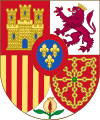Battle of Écija (1275)
The Battle of Écija (Arabic: معركة الدونونية) was a battle of the Spanish Reconquista that took place in September 1275. The battle pitted the Muslim troops of the Nasrid Emirate of Granada and its Moroccan allies against those of the Kingdom of Castile and resulted in a victory for the Emirate of Granada.
| Battle of Écija | |||||||
|---|---|---|---|---|---|---|---|
| Part of the Reconquista | |||||||
 Farmland near Écija near the spot where Nuño González de Lara was killed and decapitated. | |||||||
| |||||||
| Belligerents | |||||||
|
|
| ||||||
| Commanders and leaders | |||||||
|
|
| ||||||
The battle
The Nasrid Emirate of Granada was engulfed in a civil war and was regularly devastated by Castilian forces who saw an opportunity for easy plunder due to the distraction of the Muslim forces. Muhammad II asked for help from his Moroccan allies to ease the difficulty of fighting two wars at once. The Sultan, the Marinid Abu Yusuf Yaqub ibn Abd Al-Haqq, landed on the Iberian Peninsula in 1275 with an army and began a campaign with the strategic objective to occupy the city of Tarifa. The Castilian King, Alfonso X of Castile was abroad at the time and the country was ruled by his son, infante Ferdinand acting as regent. He immediately raised some troops and moved south but unexpectedly died of natural causes in Villa Real in August 1275.
While marching north, the Muslim forces encountered a Castilian army under the command of Nuño González de Lara "el Bueno", member of the House of Lara and adelantado mayor de Andalucia, who attempted to cut off the Marinid route near the town of Écija. The Marinid forces routed the Castilian army and Nuño González de Lara was killed in the action or shortly thereafter.[1] The Marinid Sultan ordered that Nuño González' head be cut off, sending it as a trophy to the Sultan of Granada, Muhammad II and cementing his alliance with them which would continue for the next few years against the Castilian forces.
In October, a second army led by Archbishop Sancho of Toledo met a similar defeat in the battle of Martos. The kingdom in the end was saved by the infante Sancho of Castile who rallied the Castilian forces. At the end of the year, King Alfonso X of Castile was forced to sign a peace treaty with the Muslims.
References
- Díez, Gonzalo Martínez (2005). El Condado de Castilla, 711-1038: La Historia Frente a La Leyenda (in Spanish). Marcial Pons Historia. p. 41. Retrieved 27 December 2016.
